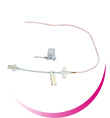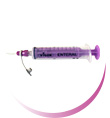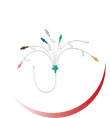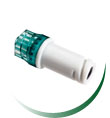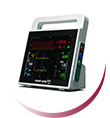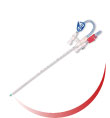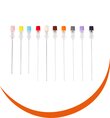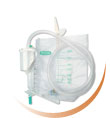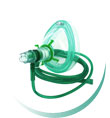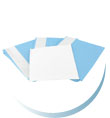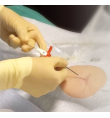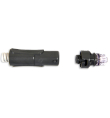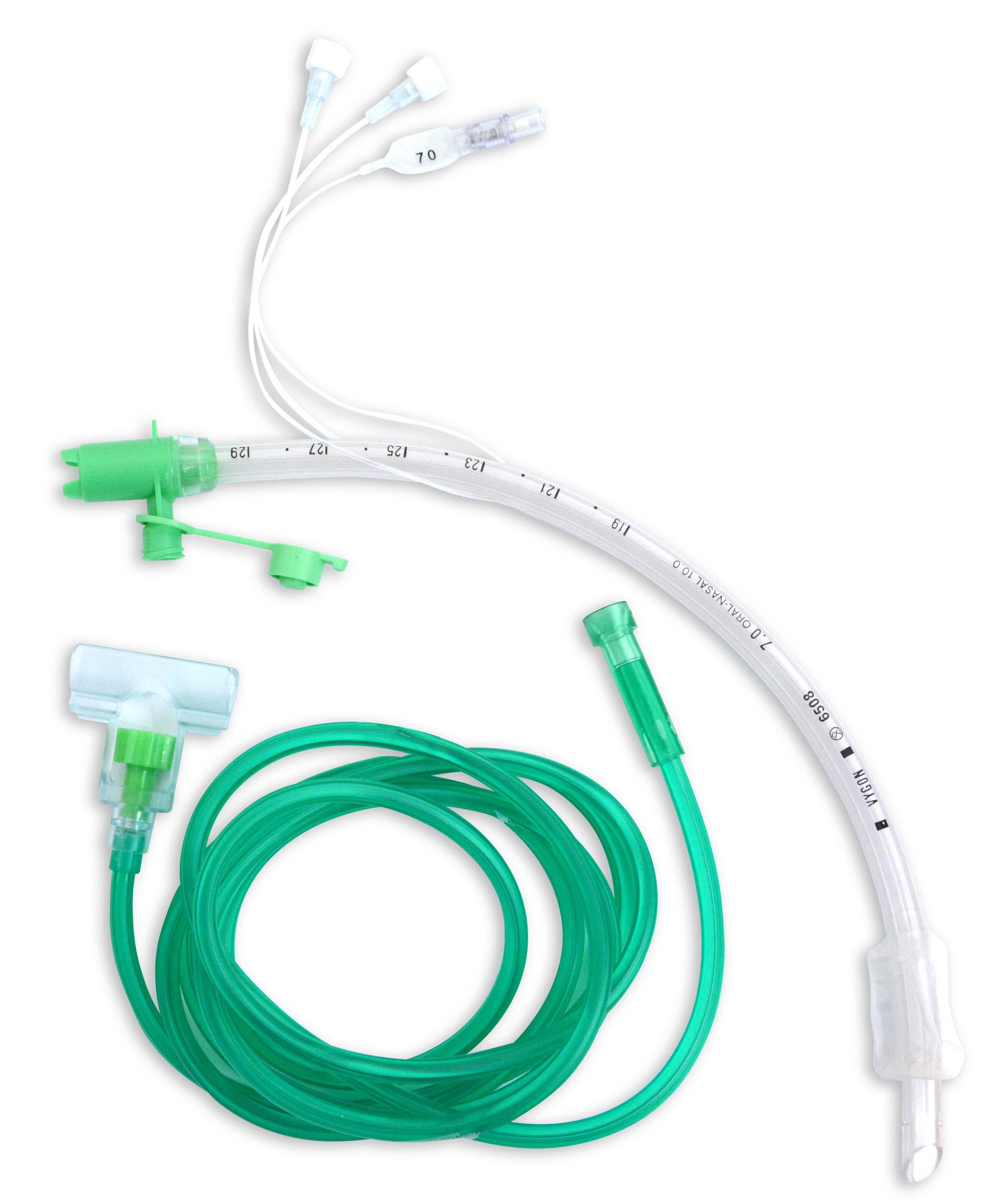Reanimatietube Boussignac ø 7,0 mm
New concept of endotracheal tube with capillaries moulded into the tubing wall. When gas is injected through these capillaries, turbulence is created at the distal end of the tube, creating a "virtual valve". Continuous insufflation of 15 liters/min of oxygen into the micro-capillaries generates intra-pulmonary pressure of 8 - 10 cm H2O and allows PASSIVE OXYGENATION.
- A single person resuscitating can perform CONTINUOUS CARDIAC MASSAGE. The continous cardiac massage, as well as the continuous insufflation of oxygen improves haemodynamics and therefore preserves the vital organs as much as possible.
When cardio-pulmonary resuscitation is performed with a standard E.T. tube, the energy of the thoracic compressions during cardiac massage is dispersed by the intra-pulmonary air, extremely compressible (which represents approximately 70% of the volume of the thoracic cage). Furthermore after with each compression the air escapes freely through the airways. Consequently the energy developped during cardiac massage is insufficiently transmitted to the cardiac pump thus overall haemodynamics is reduced compared to the haemodynamics obtained with the Boussignac CPR system.
With Boussignac CPR system, the continuous insufflation of oxygen through the micro-capillaries of the tube will increase the intra-pulmonary pressure and at the same time, the "virtual valve" creates a resistance which will prevent the air from escaping freely during cardiac compressions. Consequently the energy developped during cardiac massage is efficiently transmitted to the cardiac pump, thus improving overall haemodynamics.
- The continuous flow of oxygen allows satisfactory CO2 elimination due to constant dead space washout. Furthermore because the oxygen exits close to the carina, the quality of alveolar air is improved.
- The proximal end of the tube is open to the atmosphere. Constant insufflation of oxygen and continuous chest compressions ensure SIMULTANEOUSLY cardiac massage AND ventilation, thus allowing perfect synchronisation between massage and ventilation.
This helps prevent barotrauma, occuring in standard management of cardiac arrest, caused by the lack of synchronisation between the resuscitator performing cardiac massage and the ventilator or resuscitation bag.
- Performing cardiac massage with inflated alveoles will REDUCE THE DAMAGE CAUSED TO THE LUNGS and the risk of RIB FRACTURE.
To summarize, the Boussignac CPR system allows life-compatible oxygenation, improved haemodynamics, a decrease of lung complications related to cardiac massage and a perfect synchronisation between cardiac massage and ventilation.
Characteristics :
- Transparent PVC tube with radiopaque line
- 5 micro-capillaries for intra-tracheal administration of oxygen
- 1 capillary for inflating the low pressure cuff
- 2 capillaries for capnometry and/or pressure monitoring and/or injection of medication (Adrenalin)
The green extension tube (200 cm long) preconnected to the proximal adaptor of the CPR system allows to connect the device to the source of oxygen.
Note : During cardiac massage, when the green extension tube is connected to an oxygen source, an "Anti-connection" transparent plastic device prevents the connection of any type of ventilation device (manual or mechanical) on the Boussignac CPR system.
In case of ROSC (return of spontaneous circulation or cardiac activity), the green extension tube is removed and the lateral opening on the proximal adaptor can be occluded with the green cap provided. The proximal adaptor is a standard 15 mm male adaptor which allows to connect the Boussignac CPR system to a mechanical ventilator.
EtCO2 can be monitored via an adaptor (code 6508.01) connected to one of the Luer extension tubes of the CPR system.
- A single person resuscitating can perform CONTINUOUS CARDIAC MASSAGE. The continous cardiac massage, as well as the continuous insufflation of oxygen improves haemodynamics and therefore preserves the vital organs as much as possible.
When cardio-pulmonary resuscitation is performed with a standard E.T. tube, the energy of the thoracic compressions during cardiac massage is dispersed by the intra-pulmonary air, extremely compressible (which represents approximately 70% of the volume of the thoracic cage). Furthermore after with each compression the air escapes freely through the airways. Consequently the energy developped during cardiac massage is insufficiently transmitted to the cardiac pump thus overall haemodynamics is reduced compared to the haemodynamics obtained with the Boussignac CPR system.
With Boussignac CPR system, the continuous insufflation of oxygen through the micro-capillaries of the tube will increase the intra-pulmonary pressure and at the same time, the "virtual valve" creates a resistance which will prevent the air from escaping freely during cardiac compressions. Consequently the energy developped during cardiac massage is efficiently transmitted to the cardiac pump, thus improving overall haemodynamics.
- The continuous flow of oxygen allows satisfactory CO2 elimination due to constant dead space washout. Furthermore because the oxygen exits close to the carina, the quality of alveolar air is improved.
- The proximal end of the tube is open to the atmosphere. Constant insufflation of oxygen and continuous chest compressions ensure SIMULTANEOUSLY cardiac massage AND ventilation, thus allowing perfect synchronisation between massage and ventilation.
This helps prevent barotrauma, occuring in standard management of cardiac arrest, caused by the lack of synchronisation between the resuscitator performing cardiac massage and the ventilator or resuscitation bag.
- Performing cardiac massage with inflated alveoles will REDUCE THE DAMAGE CAUSED TO THE LUNGS and the risk of RIB FRACTURE.
To summarize, the Boussignac CPR system allows life-compatible oxygenation, improved haemodynamics, a decrease of lung complications related to cardiac massage and a perfect synchronisation between cardiac massage and ventilation.
Characteristics :
- Transparent PVC tube with radiopaque line
- 5 micro-capillaries for intra-tracheal administration of oxygen
- 1 capillary for inflating the low pressure cuff
- 2 capillaries for capnometry and/or pressure monitoring and/or injection of medication (Adrenalin)
The green extension tube (200 cm long) preconnected to the proximal adaptor of the CPR system allows to connect the device to the source of oxygen.
Note : During cardiac massage, when the green extension tube is connected to an oxygen source, an "Anti-connection" transparent plastic device prevents the connection of any type of ventilation device (manual or mechanical) on the Boussignac CPR system.
In case of ROSC (return of spontaneous circulation or cardiac activity), the green extension tube is removed and the lateral opening on the proximal adaptor can be occluded with the green cap provided. The proximal adaptor is a standard 15 mm male adaptor which allows to connect the Boussignac CPR system to a mechanical ventilator.
EtCO2 can be monitored via an adaptor (code 6508.01) connected to one of the Luer extension tubes of the CPR system.
- Contains Latex: No
- Contains DEHP: No
- Contains biogical or animal-based product: No
